Experimental–Computational Investigation of the Elastic Modulus of Mortar under Sulfate Attack
Abstract
:1. Introduction
2. Materials and Methods
2.1. Materials
2.2. Mix Design and Samples Preparation
2.3. Experimental Methods
2.3.1. Uniaxial Compression Test
2.3.2. Nanoindentation Test
2.3.3. SEM-BSE Test
3. Experimental Results and Discussion
3.1. Macroscopic Elastic Modulus of Corroded Mortar
3.2. Thickness of ITZ in Corroded Mortar
3.3. Nanoindentation Results of Corroded Mortar
4. Evaluation of the Elastic Modulus of Corroded Mortar by Homogenization Method
4.1. Homogenization Method
4.2. Mechanical Parameters of Phases
4.3. Calculation of Volume Fractions of Microphases
5. Verification of Elastic Modulus Prediction Model of Mortar under Sulfate Corrosion
5.1. Theoretical Calculation of Macroscopic Elastic Modulus of Corroded Mortar
5.2. Comparison between Experimental Results and Theoretical Prediction Results of the Macro-Elastic Modulus of Corroded Mortar
6. Conclusions
- (1)
- The BSE images of corroded mortar and the algorithm of image threshold segmenting can be used to acquire the thickness of ITZ, and the thickness of ITZ in corroded mortar at 88 d is 20 µm.
- (2)
- Combined with the results of nanoindentation test and the characteristics of corroded mortar, the macro-elastic modulus of ITZ in the corroded mortars can be accurately and effectively evaluated. The values of ITZ in corroded mortars (M1 and M2) are 15.2 GPa and 18.9 GPa, respectively.
- (3)
- Based on the mortar mix proportion and the thickness of ITZ, the volume fractions of sand, cement paste, and ITZ in corroded mortar can be well evaluated by Lu and Torquato’s model.
- (4)
- The computational elastic modulus prediction model, considering the influence of ITZ, can well predict the elastic modulus of mortar under sulfate attack.
Author Contributions
Funding
Institutional Review Board Statement
Informed Consent Statement
Data Availability Statement
Acknowledgments
Conflicts of Interest
References
- Liang, S.; Wei, Y.; Wu, Z. Multiscale modeling elastic properties of cement-based materials considering imperfect interface effect. Constr. Build. Mater. 2017, 154, 567–579. [Google Scholar] [CrossRef]
- Ikumi, T.; Cavalaro, S.H.; Segura, I.; Aguado, A. Alternative methodology to consider damage and expansions in external sulfate attack modeling. Cem. Concr. Res. 2014, 63, 105–116. [Google Scholar] [CrossRef]
- Oliver, W.C.; Pharr, G.M. Measurement of hardness and elastic modulus by instrumented indentation: Advances in under-standing and refinements to methodology. J. Mater. Res. 2004, 19, 3–20. [Google Scholar] [CrossRef]
- Hu, C.; Li, Z. Micromechanical investigation of Portland cement paste. Constr. Build. Mater. 2014, 71, 44–52. [Google Scholar] [CrossRef]
- Buljak, V.; Cocchetti, G.; Cornaggia, A.; Garbowski, T.; Maier, G.; Novati, G. Materials mechanical characterizations and structural diagnoses by inverse analyses 20. In Handbook of Damage Mechanics; Springer: New York, NY, USA, 2015; pp. 619–642. [Google Scholar]
- Huang, J.; Krabbenhoft, K.; Lyamin, A.V. Statistical homogenization of elastic properties of cement paste based on X-ray microtomography images. Int. J. Solids Struct. 2013, 50, 699–709. [Google Scholar] [CrossRef]
- Zhang, Y.; Zhang, S.; Jiang, X.; Zhao, W.; Wang, Y.; Zhu, P.; Yan, Z.; Zhu, H. Uniaxial tensile properties of multi-scale fiber reinforced rubberized concrete after exposure to elevated temperatures. J. Clean. Prod. 2023, 389, 136068. [Google Scholar] [CrossRef]
- Li, Y.; Hao, J.; Wang, Z.; Guan, Z.; Wang, R.; Chen, H.; Jin, C. Experimental-Computational Investigation of Elastic Modulus of Ultra-High-Rise Pumping Concrete. J. Adv. Concr. Technol. 2020, 18, 39–53. [Google Scholar] [CrossRef]
- Zhang, Y.; Zhang, S.; Zhao, W.; Jiang, X.; Chen, Y.; Hou, J.; Wang, Y.; Yan, Z.; Zhu, H. Influence of multi-scale fiber on residual compressive properties of a novel rubberized concrete subjected to elevated temperatures. J. Build. Eng. 2023, 65, 105750. [Google Scholar] [CrossRef]
- Bernard, O.; Ulm, F.-J.; Lemarchand, E. A multiscale micromechanics-hydration model for the early-age elastic properties of cement-based materials. Cem. Concr. Res. 2003, 33, 1293–1309. [Google Scholar] [CrossRef]
- Li, Y.; Wang, P.; Wang, Z. Evaluation of elastic modulus of cement paste corroded in bring solution with advanced ho-mogenization method. Constr. Build. Mater. 2017, 157, 600–609. [Google Scholar] [CrossRef]
- Chen, H.S.; Stroeven, P.; Ye, G.; Stroeven, M. Influence of Boundary Conditions on Pore Percolation in Model Cement Paste. Key Eng. Mater. 2006, 302–303, 486–492. [Google Scholar] [CrossRef]
- Chen, H.; Sun, W.; Stroeven, P. Interfacial transition zone between aggregate and paste in cementitious composites (I): Ex-perimental techniques. J. Chin. Ceram. Soc. 2004, 32, 63–69. [Google Scholar]
- Chen, H.; Stroven, P. Interfacial transition zone between aggregate and paste in cementifious composties (II): Mechanism of formation and degradation of interfacial transition zone microstructure and its influence factors. J. Chin. Ceram. Soc. 2004, 32, 70–79. [Google Scholar]
- Machoviè, V.; Kopecký, L.; Němeček, J.; Kolář, F.; Svítilová, J.; Bittnar, Z.; Andertová, J. Raman micro-spectroscopy mapping and microstructural and micromechanical study of interfacial transition zone in concrete reinforced by poly(ethylene tereph-thalate) fibres. Ceram. Silik. 2008, 52, 54–60. [Google Scholar]
- Lutz, M.P.; Monteiro, P.J.; Zimmerman, R.W. Inhomogeneous Interfacial Transition Zone Model for the Bulk Modulus of Mortar. Cem. Concr. Res. 1997, 27, 1113–1122. [Google Scholar] [CrossRef]
- Mondai, P.; Shah, S.R.; Marks, L.D. Nanoscale characterization of cementitious materials. Aci Mater. J. 2008, 105, 174–179. [Google Scholar]
- Mondal, P.; Shah, S.P.; Marks, L.D. Nanomechanical Properties of Interfacial Transition Zone in Concrete. In Nanotechnology in Construction 3: Proceedings of the NICOM3; Springer: Berlin/Heidelberg, Germany, 2009; pp. 315–320. [Google Scholar]
- Chen, H.S. Quantitative calculation of volume fraction of interface transition zone in cement based composites. J. Harbin Inst. Technol. 2006, 23, 133–142. [Google Scholar]
- Chen, H.; Sun, W.; Stroeven, P.; Sluys, L.J. Analytical solution of the nearest surface spacing between neighboring aggregate grains in cementitious composites. J. Chin. Ceram. Soc. 2005, 33, 859–863. [Google Scholar]
- Han, J.; Pan, G.; Sun, W. Elastic modulus change investigation of cement paste before and after carbonation using nanoindentation technique. Procedia Eng. 2012, 27, 341–347. [Google Scholar] [CrossRef]
- Li, Y.; Zhang, G.; Wang, Z.; Wang, P.; Guan, Z. Integrated experimental-computational approach for evaluating elastic modulus of cement paste corroded in brine solution on microscale. Constr. Build. Mater. 2018, 162, 459–469. [Google Scholar] [CrossRef]
- Oliver, W.C.; Pharr, G.M. An improved technique for determining hardness and elastic modulus using load and displacement sensing indentation experiments. J. Mater. Res. 1992, 7, 1564–1583. [Google Scholar] [CrossRef]
- Scrivener, K.L.; Crumbie, A.K.; Laugesen, P. The Interfacial Transition Zone (ITZ) Between Cement Paste and Aggregate in Concrete. Interface Sci. 2004, 12, 411–421. [Google Scholar] [CrossRef]
- Bernard, F.; Kamali-Bernard, S. Numerical study of ITZ contribution on mechanical behavior and diffusivity of mortars. Comput. Mater. Sci. 2015, 102, 250–257. [Google Scholar] [CrossRef]
- Yun, G.; Schutter, G.D.; Ye, G.; Huang, H.; Tan, Z.; Kai, W. Porosity characterization of ITZ in cementitious composites: Concentric expansion and overflow criterion. Constr. Build. Mater. 2013, 38, 1051–1057. [Google Scholar]
- Sun, X.; Dai, Q.; Ng, K. Computational investigation of pore permeability and connectivity from transmission X-ray microscope images of a cement paste specimen. Constr. Build. Mater. 2014, 68, 240–251. [Google Scholar] [CrossRef]
- Lafhaj, Z.; Goueygou, M.; Djerbi, A.; Kaczmarek, M. Correlation between porosity, permeability and ultrasonic parameters of mortar with variable water/cement ratio and water content. Cem. Concr. Res. 2006, 36, 625–633. [Google Scholar] [CrossRef]
- Zou, D.; Cheng, H.; Liu, T.; Qin, S.; Yi, T.-H. Monitoring of concrete structure damage caused by sulfate attack with the use of embedded piezoelectric transducers. Smart Mater. Struct. 2019, 28, 105039. [Google Scholar] [CrossRef]
- Hill, R. Theory of mechanical properties of fibre-strengthened materials—III Self-consistent model. J. Mech. Phys. Solids 1965, 13, 189–198. [Google Scholar] [CrossRef]
- Budiansky, B. On the elastic moduli of some heterogeneous materials. J. Mech. Phys. Solids 1965, 13, 223–227. [Google Scholar] [CrossRef]
- Eshelby, J.D. The determination of the elastic field of an ellipsoidal inclusion, and related problems. Proc. R. Soc. Lond. 1957, 241, 376–396. [Google Scholar]
- Timoshenko, S.; Goodier, J. Theory of Elasticity, 3rd ed.; Mc Graw Hill: New York, NY, USA, 1970. [Google Scholar]
- Christensen, R.M. Mechanics of Composite Materials; John Wiley & Sons, Inc.: New York, NY, USA, 1979. [Google Scholar]
- Christensen, R.; Lo, K. Solutions for effective shear properties in three phase sphere and cylinder models. J. Mech. Phys. Solids 1979, 27, 315–330. [Google Scholar] [CrossRef]
- Zhu, H.; Chen, Q.; Yan, Z.; Ju, J.W.; Zhou, S. Micromechanical models for saturated concrete repaired by the electrochemical deposition method. Mater. Struct. 2013, 47, 1067–1082. [Google Scholar] [CrossRef]
- Sun, C.; Chen, J.; Zhu, J.; Zhang, M.; Ye, J. A new diffusion model of sulfate ions in concrete. Constr. Build. Mater. 2013, 39, 39–45. [Google Scholar] [CrossRef]
- Rajasekaran, G. Sulphate attack and ettringite formation in the lime and cement stabilized marine clays. Ocean Eng. 2005, 32, 1133–1159. [Google Scholar] [CrossRef]
- Chen, J.-K.; Jiang, M.-Q. Long-term evolution of delayed ettringite and gypsum in Portland cement mortars under sulfate erosion. Constr. Build. Mater. 2009, 23, 812–816. [Google Scholar] [CrossRef]
- Bonakdar, A.; Mobasher, B. Multi-parameter study of external sulfate attack in blended cement materials. Constr. Build. Mater. 2010, 24, 61–70. [Google Scholar] [CrossRef]
- Li, Y.; Li, Y.; Wang, P.; Wang, Z.; Guan, Z. Methodology of Evaluating Elastic Modulus of Cement Mortar Corroded in Brine. J. Adv. Concr. Technol. 2019, 17, 434–448. [Google Scholar] [CrossRef]
- Li, Y.; Guan, Z.; Wang, Z.; Zhang, G.; Ding, Q. Evaluation of Elastic Modulus of Cement Paste in Sodium Sulfate Solution by an Advanced X-CT-Hydration-Deterioration Model with Self-Consistent Method. Adv. Cem. Res. 2019, 32, 1–41. [Google Scholar] [CrossRef]
- Tennis, P.D.; Jennings, H.M. A model for two types of calcium silicate hydrate in the microstructure of Portland cement pastes. Cem. Concr. Res. 2000, 30, 855–863. [Google Scholar] [CrossRef]
- Jennings, H.M. Refinements to colloid model of C-S-H in cement: CM-II. Cem. Concr. Res. 2008, 38, 275–289. [Google Scholar] [CrossRef]
- Wu, L.; Song, G.; Lei, B. Prediction of elastic modulus of hardend cement pastes. J. Build. Mater. 2011, 14, 819–823. [Google Scholar]
- Lv, J. Prediction of the Elastic Moduli of Cement-Based Materials; Zhejiang University of Technology: Zhejiang, China, 2007. [Google Scholar]
- Sun, G.; Sun, W.; Zhang, Y.; Liu, Z. Quantitative calculation on volume fraction of hydrated products in Portland cement. J. Southeast Univ. Nat. Sci. Ed. 2011, 41, 606–610. [Google Scholar]
- Chen, H.; Sun, W.; Zhou, Y.; Piet, S.; Johannes, S.L. Analytical solution of the nearest surface spacing between neighboring binder grains in fresh cement paste. Acta Mater. Compos. Sin. 2007, 24, 127–133. [Google Scholar]
- Garboczi, E.J.; Bentz, D.P. Analytical formulas for interfacial transition zone properties. Adv. Cem. Based Mater. 1997, 6, 99–108. [Google Scholar] [CrossRef]
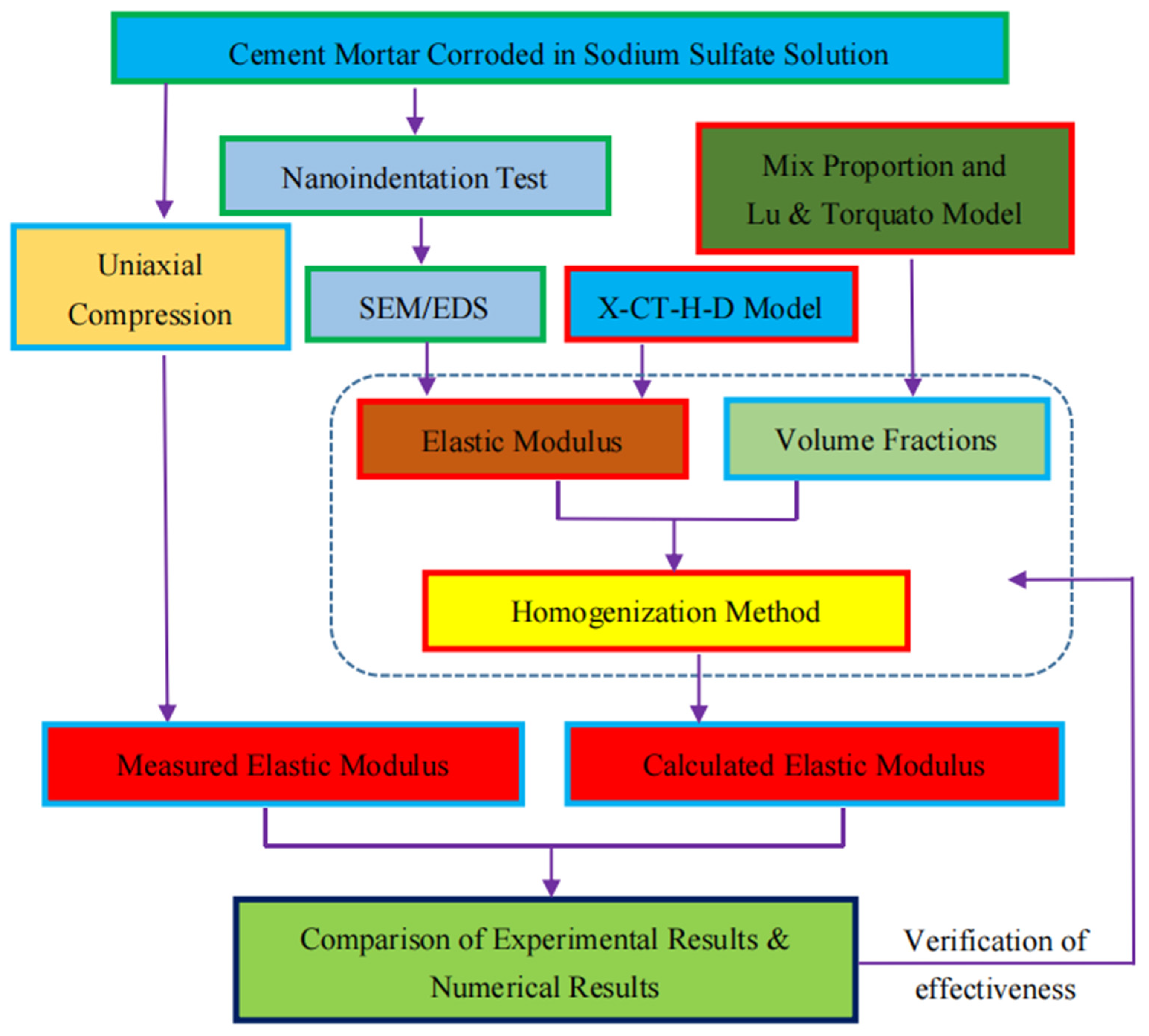

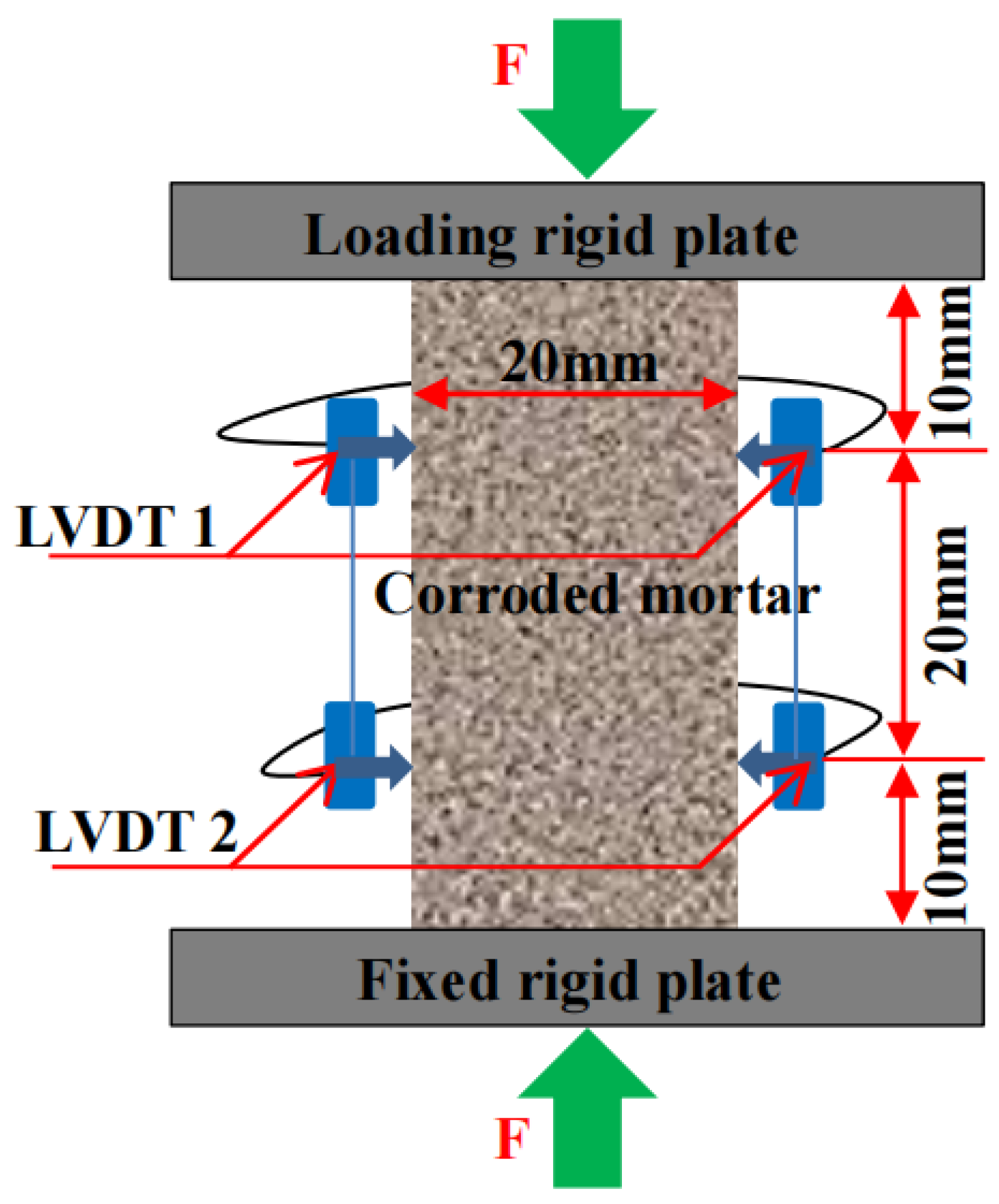
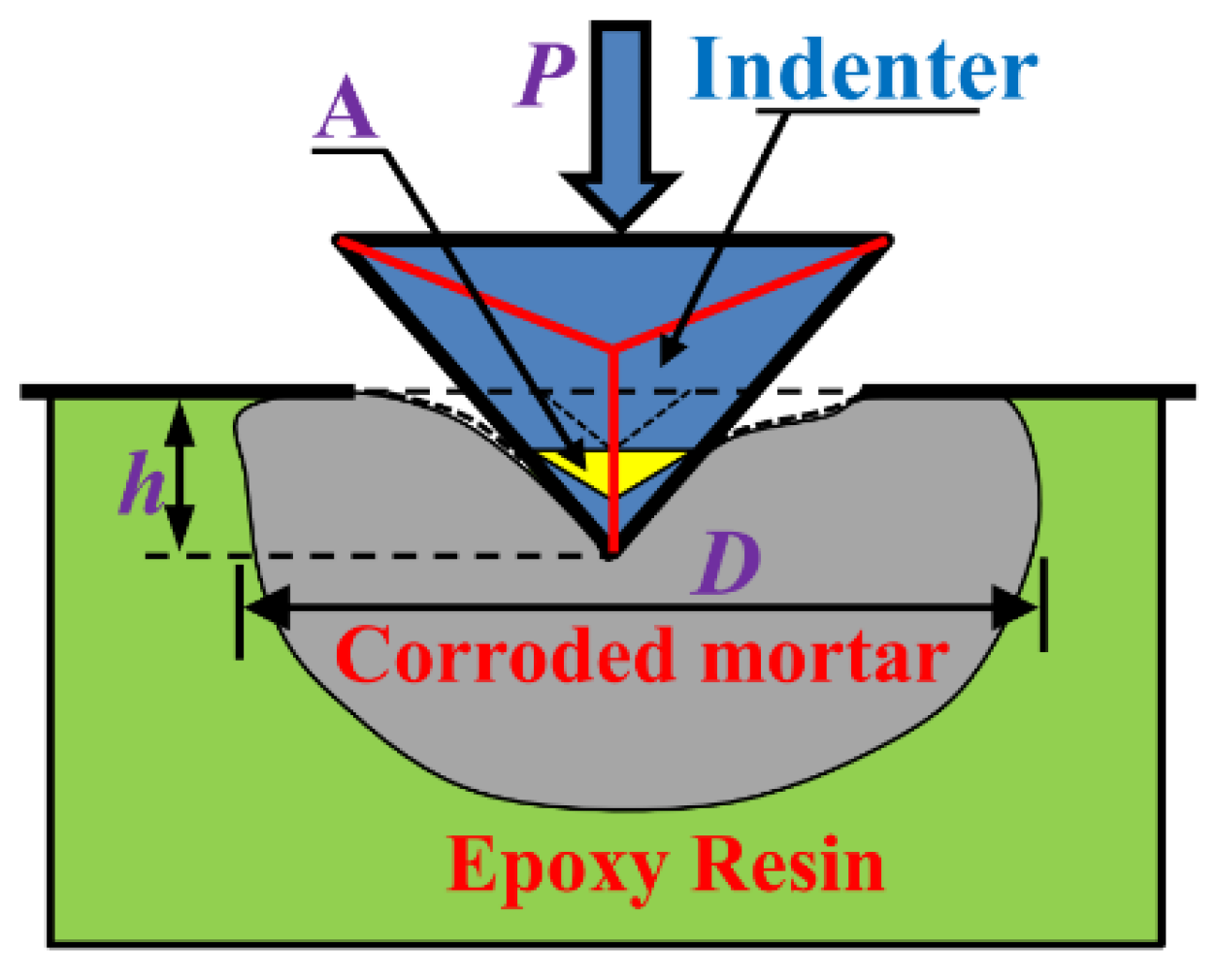
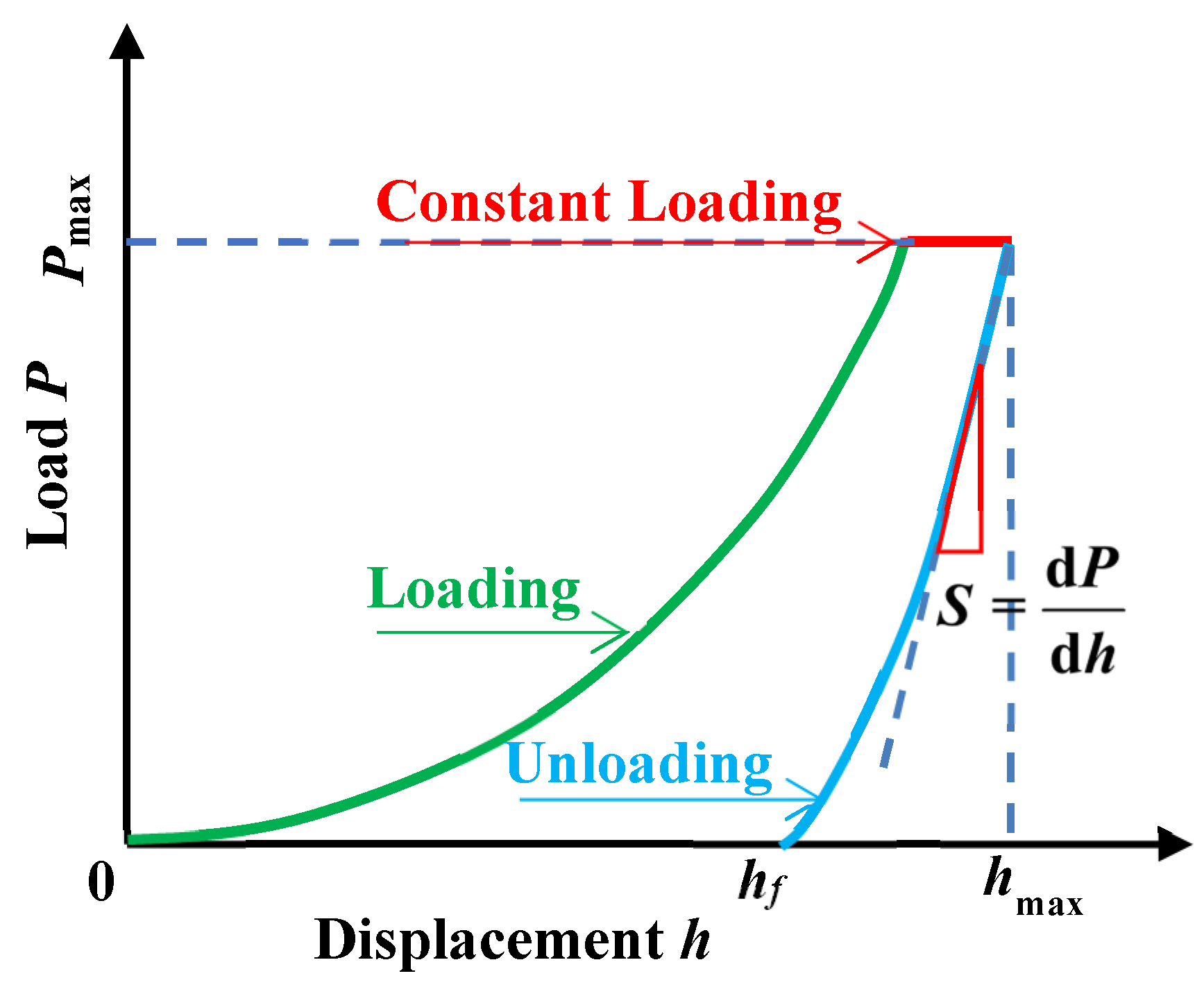
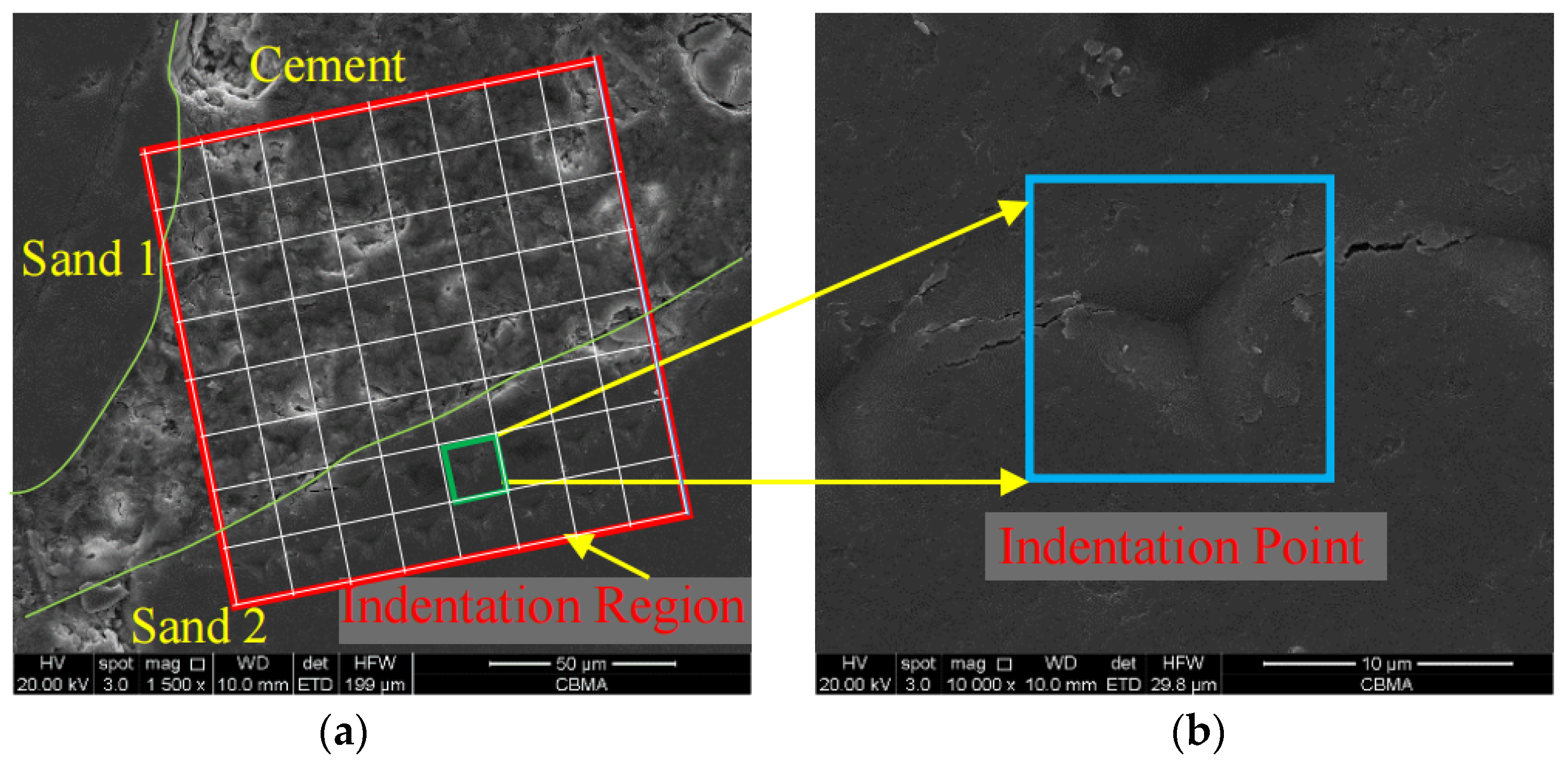
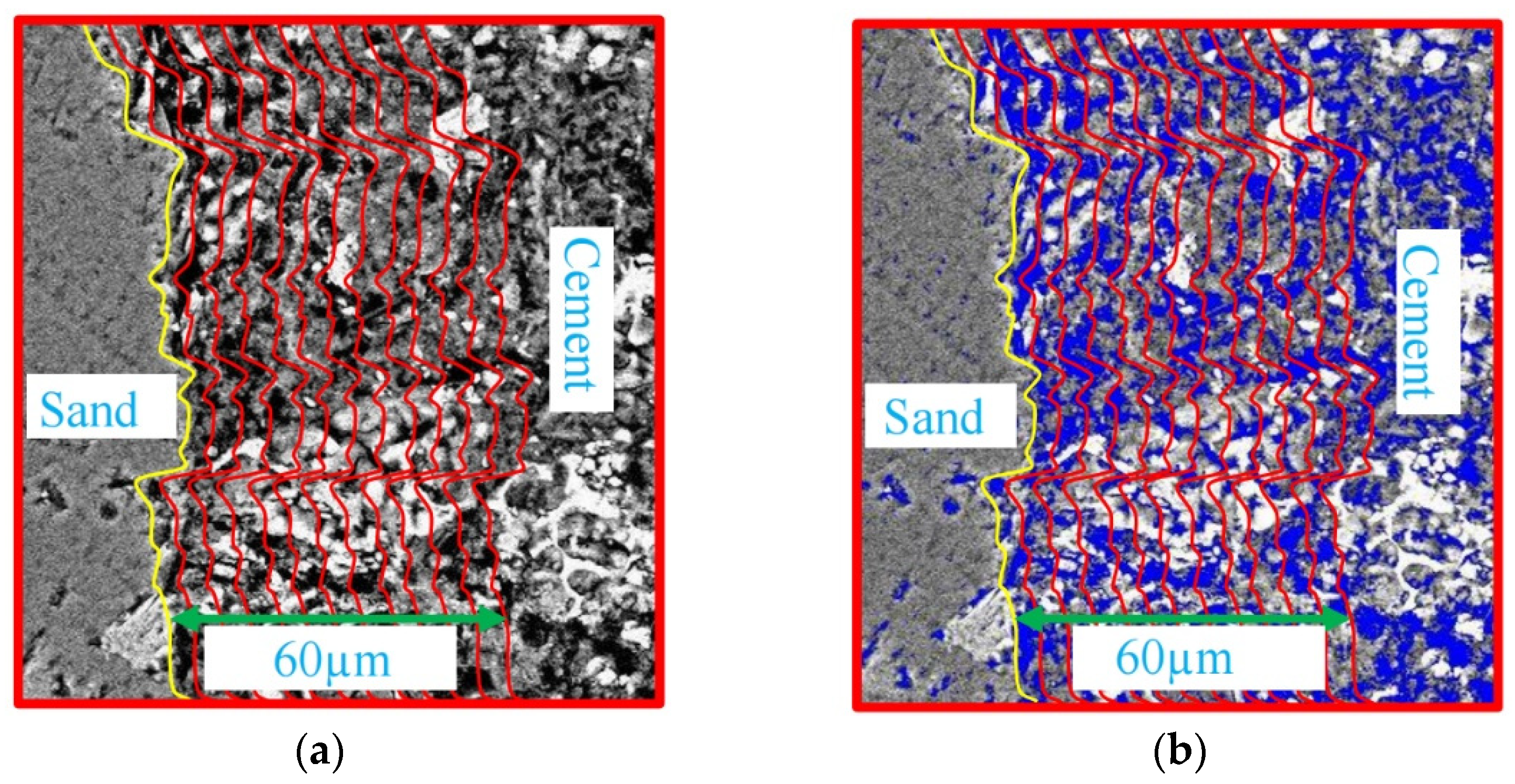

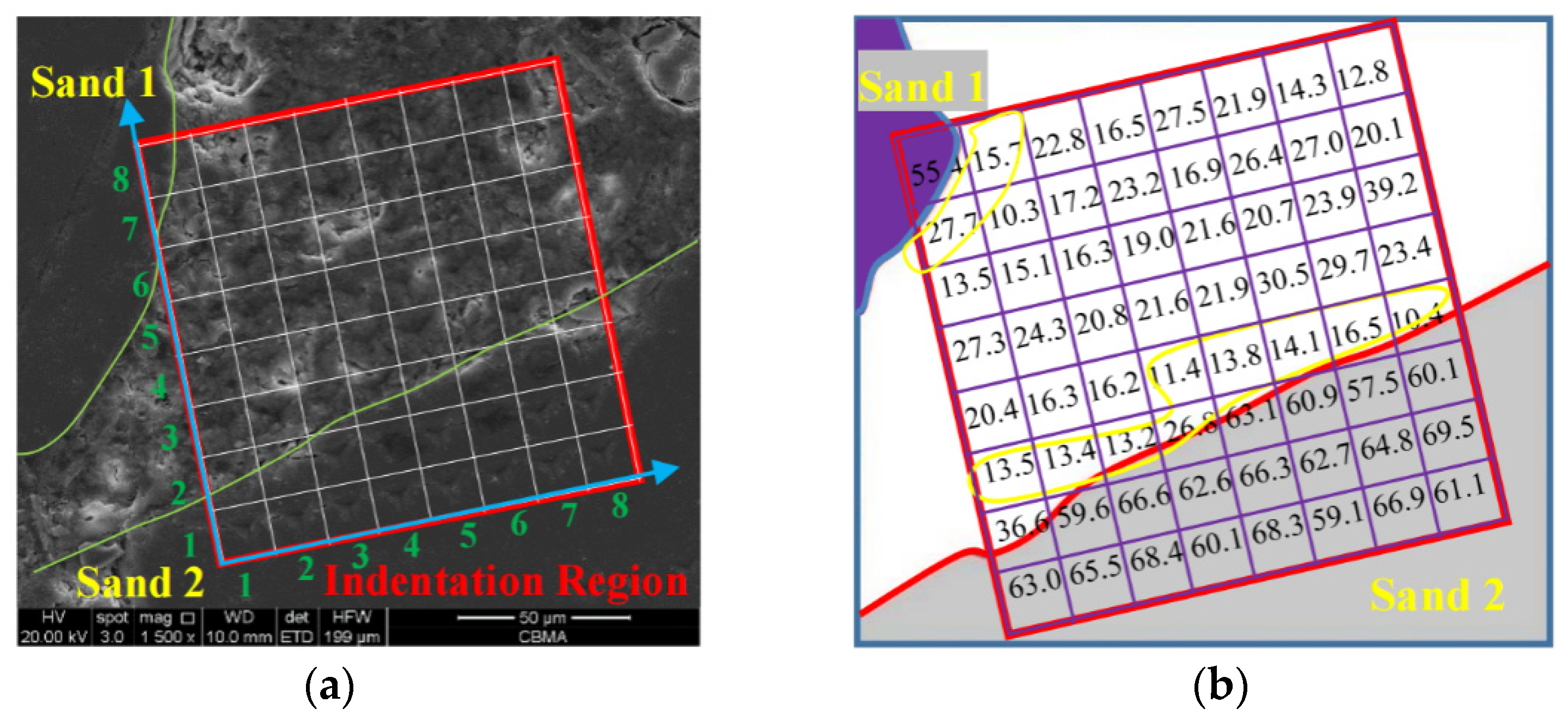
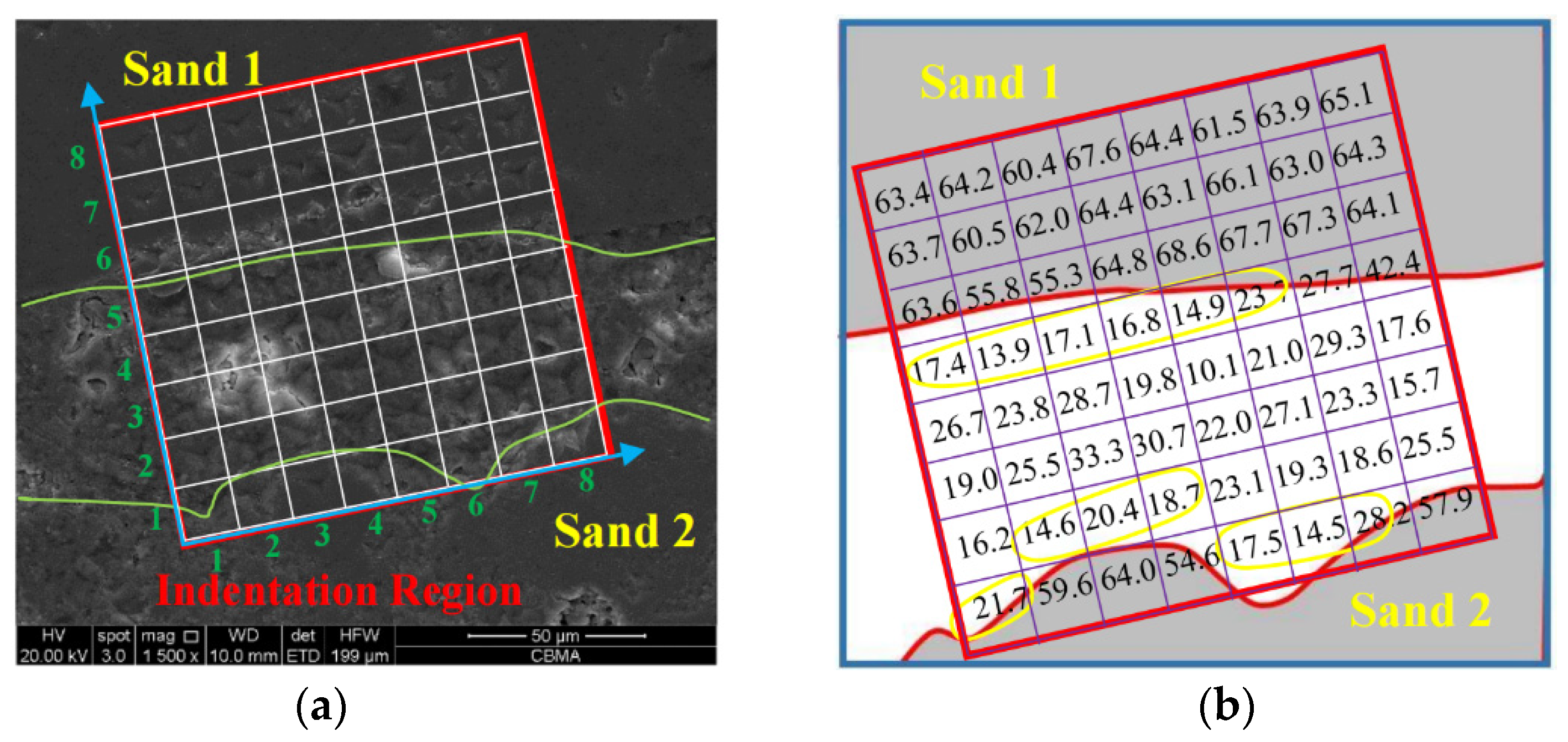

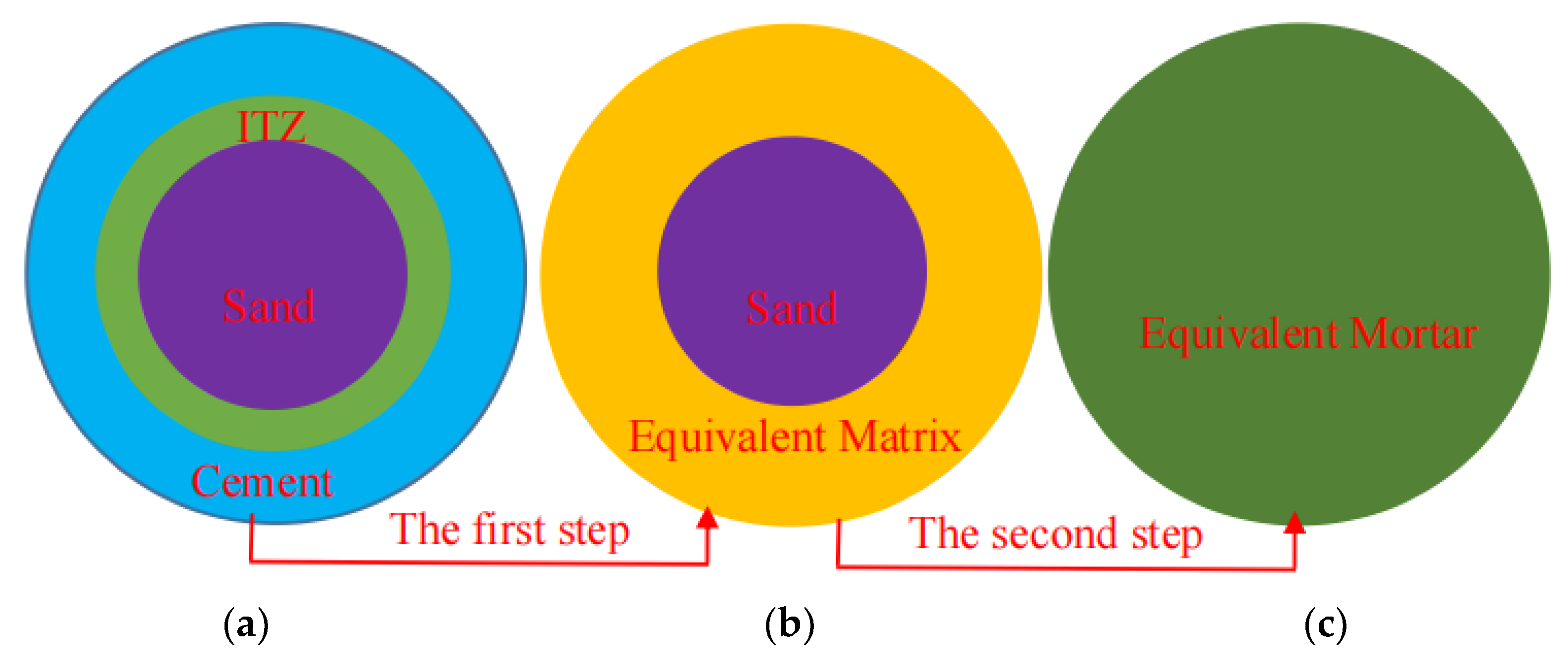

| Composition | C3A | C2S | C3S | C4AF |
|---|---|---|---|---|
| Content (%) | 7.41 | 16.79 | 63.94 | 11.86 |
| Type | Water (g) | Cement (g) | Sand (g) | w/c |
|---|---|---|---|---|
| M1 | 400 | 750 | 1500 | 0.53 |
| M2 | 312.2 | 900 | 1350 | 0.35 |
| w/c | Bulk Modulus | Shear Modulus | Elastic Modulus |
|---|---|---|---|
| 0.53 | 14.03 | 8.63 | 21.48 |
| 0.35 | 15.13 | 9.33 | 23.22 |
| Type | Sand | Cement Paste | ITZ |
|---|---|---|---|
| M1 | 47.0 | 41.9 | 11.1 |
| M2 | 46.0 | 43.1 | 10.9 |
| Homogenization Process | Input Parameters | Output Results | ||||
|---|---|---|---|---|---|---|
| Elastic Parameters | Volume Fractions | Elastic Parameters | ||||
| (GPa) | (GPa) | (%) | (GPa) | (GPa) | E (GPa) | |
| Level I: Equivalent matrix (SC method) | ||||||
| ITZ | 9.74 | 6.13 | 20.94 | 12.98 | 8.04 | 19.99 |
| Cement | 14.03 | 8.63 | 79.06 | |||
| Level II: mortar (two-phase ball model) | ||||||
| Equivalent matrix | 12.98 | 8.04 | 53 | 17.90 | 13.51 | 32.38 |
| Sand | 29.28 | 27.74 | 47 | |||
| Homogenization Process | Output Results | Output Results | ||||
|---|---|---|---|---|---|---|
| Elastic Parameters | Volume Fractions | Elastic Parameters | ||||
| (GPa) | (GPa) | (%) | (GPa) | (GPa) | E (GPa) | |
| Level I: Equivalent matrix (SC method) | ||||||
| ITZ | 12.12 | 7.62 | 20.55 | 14.45 | 8.95 | 22.25 |
| Cement | 15.13 | 9.33 | 79.45 | |||
| Level II: mortar (two -phase ball model) | ||||||
| Equivalent matrix | 14.45 | 8.95 | 54 | 18.84 | 14.16 | 33.97 |
| Sand | 29.28 | 27.74 | 47 | |||
Disclaimer/Publisher’s Note: The statements, opinions and data contained in all publications are solely those of the individual author(s) and contributor(s) and not of MDPI and/or the editor(s). MDPI and/or the editor(s) disclaim responsibility for any injury to people or property resulting from any ideas, methods, instructions or products referred to in the content. |
© 2023 by the authors. Licensee MDPI, Basel, Switzerland. This article is an open access article distributed under the terms and conditions of the Creative Commons Attribution (CC BY) license (https://creativecommons.org/licenses/by/4.0/).
Share and Cite
Guan, Z.; Zhang, H.; Gao, Y.; Song, P.; Li, Y.; Wu, L.; Wang, Y. Experimental–Computational Investigation of the Elastic Modulus of Mortar under Sulfate Attack. Materials 2023, 16, 6167. https://doi.org/10.3390/ma16186167
Guan Z, Zhang H, Gao Y, Song P, Li Y, Wu L, Wang Y. Experimental–Computational Investigation of the Elastic Modulus of Mortar under Sulfate Attack. Materials. 2023; 16(18):6167. https://doi.org/10.3390/ma16186167
Chicago/Turabian StyleGuan, Zhongzheng, Haochang Zhang, Yan Gao, Pengfei Song, Yong Li, Lipeng Wu, and Yichao Wang. 2023. "Experimental–Computational Investigation of the Elastic Modulus of Mortar under Sulfate Attack" Materials 16, no. 18: 6167. https://doi.org/10.3390/ma16186167




